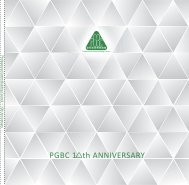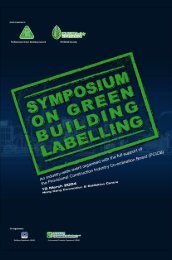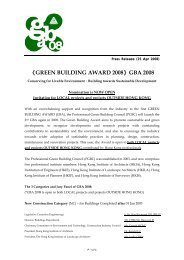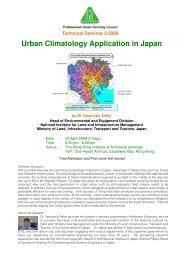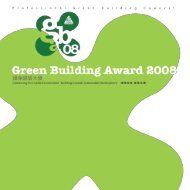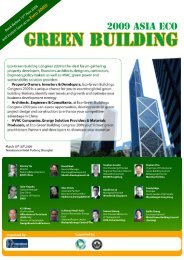Paper - The Professional Green Building Council
Paper - The Professional Green Building Council
Paper - The Professional Green Building Council
Create successful ePaper yourself
Turn your PDF publications into a flip-book with our unique Google optimized e-Paper software.
SB07HK – Sustainable <strong>Building</strong> Conference Hong Kong, 4-5 December 2007<br />
Designers and awarding authorities are normally<br />
concerned with the single building as the relevant<br />
object of interest. Methods for analysing energy and<br />
mass flows are used accompanying the design and<br />
planning stages in order to investigate and influence<br />
the impacts of design decisions on resource use and<br />
environmental impacts within the building’s life cycle.<br />
At the moment it is discussed if and to what extent<br />
the impacts of the choice of location on traffic and<br />
expenses for infrastructure have to be taken into account<br />
within the scope of sustainability assessments<br />
of buildings. <strong>The</strong> author is supportive of this practice<br />
but recommends reporting the results separately.<br />
In order to assess economic aspects life cycle<br />
costing methods are normally applied. From the authors<br />
point of view this should be extended to also<br />
include aspects of cash flow and development of<br />
value.<br />
Other objects of assessments are regions, settlements,<br />
quarters, building products (in the sense of<br />
providing environmental and health-related information)<br />
as well as the companies of the construction,<br />
housing, and property sector which have an interest<br />
on their part in a sustainable company development.<br />
In summary, it can be stated that comparable assessment<br />
criteria and indicators only exist for the<br />
evaluation of resource use and the impacts on the<br />
environment. Furthermore, life cycle assessment<br />
(LCA) represents a generally accepted method which<br />
is suitable for all assessment objects and which can<br />
be applied at all levels (e.g. building product, single<br />
building, town, region, etc.); differences exist regarding<br />
the respective reference value or basis. In order to<br />
assess and evaluate economic and social aspects it<br />
is, however, required to develop and apply criteria,<br />
indicators and assessment methods that are adjusted<br />
to both the level and object of assessment and which<br />
fit to the interests and viewpoints of the specific actor<br />
concerned.<br />
After having provided a brief interpretation of the<br />
concept of sustainability from the property industry‘s<br />
point of view the question arises how sustainability<br />
issues can be integrated into property related decision<br />
making processes and how the industry’s actors<br />
can be supported by appropriate methods and tools.<br />
3. From theory to practice – recent developments<br />
towards the transformation of property<br />
and construction markets<br />
3.1 Further development of building assessment tools<br />
<strong>The</strong> discussion and efforts on the further development<br />
of building assessment tools are currently<br />
focused on improving the reliability of assessment<br />
results and safeguarding scientific rigour while at the<br />
same time enhancing applicability and adjusting tools<br />
to decision makers’ requirements. Within international<br />
standardisation activities at ISO, European activities<br />
at CEN but also within the discussion on the development<br />
of a national building certification system in<br />
Germany it is now generally agreed that assessments<br />
of buildings’ contribution to sustainable development<br />
shall be based on quantitative results provided by<br />
LCA and LCC.<br />
However, from the author’s point of view the application<br />
of many existing assessment tools does not<br />
yet provide (in an integrated and quantitative manner)<br />
building owners, tenants or decision makers with appropriate<br />
information on the impacts of their actions<br />
and decisions on the environment, on building users’<br />
health and well-being as well as on construction costs.<br />
This restricts the possibility of increasing the actors’<br />
motivation as well as their willingness and ability to<br />
take individual responsibility.<br />
To date the market prefers tools that are predominantly<br />
based on qualitative information because of<br />
their ease of use (which saves cost and time) and<br />
because their assessment results can be easily applied<br />
for marketing purposes. In addition, these tools<br />
can be applied to assess existing buildings with only<br />
minor adjustments of their check-list type compiled<br />
requirements. However, their main disadvantage is<br />
that they do not provide building owners or tenants<br />
with appropriate information on the impacts of their<br />
actions on the environment. Statements describing<br />
impacts are missing, e.g. ‘tons of CO2 emission per<br />
capita, per m 2 , per m 3 and for housing purposes per<br />
annum.’ In addition, it is not possible to subsequently<br />
use qualitative assessment results for aggregation<br />
purposes at another level (e.g. community, or national<br />
building stock). In contrast, LCA based tools are capable<br />
of demonstrating the impacts of actors’ actions<br />
on the environment by using appropriate reference<br />
values.<br />
By demonstrating how energy and mass flows or<br />
CO2-emmissions are caused through individual actors’<br />
decisions and actions LCA based tools will potentially<br />
increase actors’ motivation as well as their<br />
willingness and ability to take self responsibility. Furthermore,<br />
assessment results of LCA based tools can<br />
be used for aggregation purposes at the community<br />
or building stock level. However, existing LCA based<br />
tools have been solely focused on the assessment of<br />
new buildings at the design and planning phase or<br />
short after completion. Methodical problems exist in<br />
connection with the assessment of existing buildings<br />
(e.g. treatment of embodied energy). Another problem<br />
regarding LCA based tools is that although approaches<br />
like ‘ECOindicator’ or ‘environmental impact<br />
scores’ exist, there is a lack of a commonly accepted<br />
method for summarizing or aggregating assessment<br />
results. In sum, there is a conflict between researchers’<br />
claims and marketing demands which hampers<br />
the use of LCA based results for marketing purposes.<br />
A number of other instruments and tools for calculating<br />
building construction costs – on a national<br />
building cost data basis – have existed for a long time.<br />
In many cases these instruments and tools have now<br />
been extended to allow for a calculation and assessment<br />
of life cycle or whole life costs (LCC or WLC).<br />
However, due to the complexity of integrating LCA<br />
and LCC/WLC methodology only a few tools exist that<br />
allow for a combined determination and assessment<br />
of environmental and economic issues within the design<br />
and planning phase; e.g. OGIP from Switzerland<br />
and LEGEP from Germany. LEGEP is considered as



